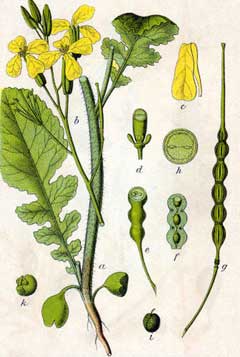
Wild Radish
Latin Name: Raphanus raphanistrum
USDA Hardiness: Coming soon
Native Range: TEMPERATE ASIA: Cyprus, Iran, Iraq, Israel, Jordan, Lebanon, Syria, Turkey, Russian Federation-Ciscaucasia (Ciscaucasia), Armenia, Azerbaijan, Georgia EUROPE: Denmark, Finland, United Kingdom, Ireland, Norway, Sweden, Austria, Belgium, Switzerland, Czech Republic, Germany, Hungary, Netherlands, Poland, Slovakia, Russian Federation (European part), Belarus, Estonia, Lithuania, Latvia, Moldova, Ukraine (incl. Krym), Albania, Bulgaria, Bosnia and Herzegovina, Greece (incl. Crete), Croatia, Italy (incl. Sardinia, Sicily), North Macedonia, Montenegro, Romania, Serbia, Slovenia, Spain (incl. Baleares), France (incl. Corsica), Portugal AFRICA: Spain (Canarias), Portugal (Madeira Islands), Algeria (north), Egypt (north), Libya (north), Morocco, Tunisia
Edibility Rating: 2 / 5
Medicinal Rating: 1 / 5
Region:
Family:
Plant Type:
Medicinal Uses
Edible Uses
Edible Parts: Flowers Leaves Oil Seed Seedpod | Edible Uses: Condiment OilYoung leaves - raw or cooked[2, 105]. A somewhat hot taste, they are finely cut and added to salads or used as a potherb[183]. It is best to use just the young leaves in spring, older leaves soon become bitter[9]. Seed - raw or cooked. A very pungent flavour, the seed can be ground into a powder and made into a paste when it is an excellent substitute for mustard[2, 9, 115, 183]. The sprouted seeds have a somewhat hot spicy flavour and are a tasty addition to salads[183]. Flowers - raw. A nice addition to salads. The flower buds are used as a broccoli substitute, they should be lightly steamed for no more than 5 minutes[9]. Young seedpods - raw. Crisp and juicy, they must be eaten when young because they quickly become tough and fibrous[K]. An edible oil is obtained from the seed[115].
Cultivation
Prefers a rich soil with ample moisture[16, 52]. Dislikes very heavy soils[37]. This plant is a host of an eelworm that attacks cultivated crops[13]. This species is possibly the original source of the cultivated radish, R. sativus[46]. The flowers are very attractive to bees[108].
Known Hazards
None known
Habitats
A weed of fields and pastures[9, 17], usually on sandy non-calcareous soils[13]